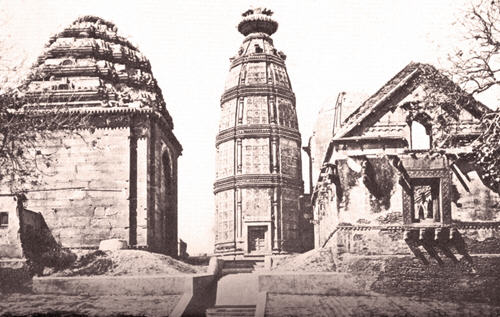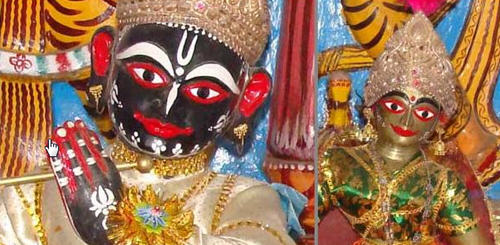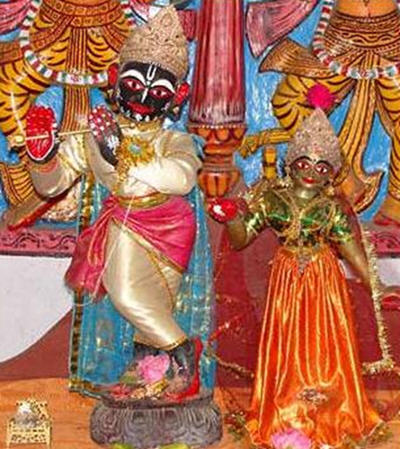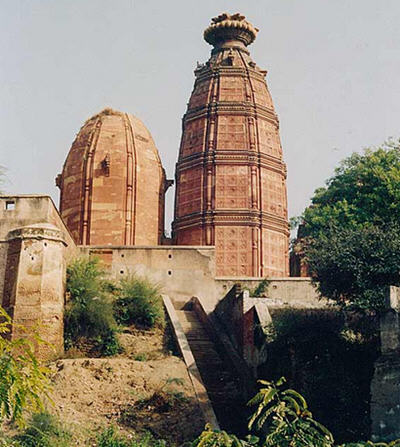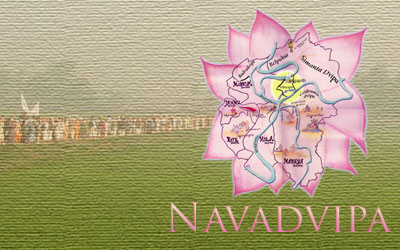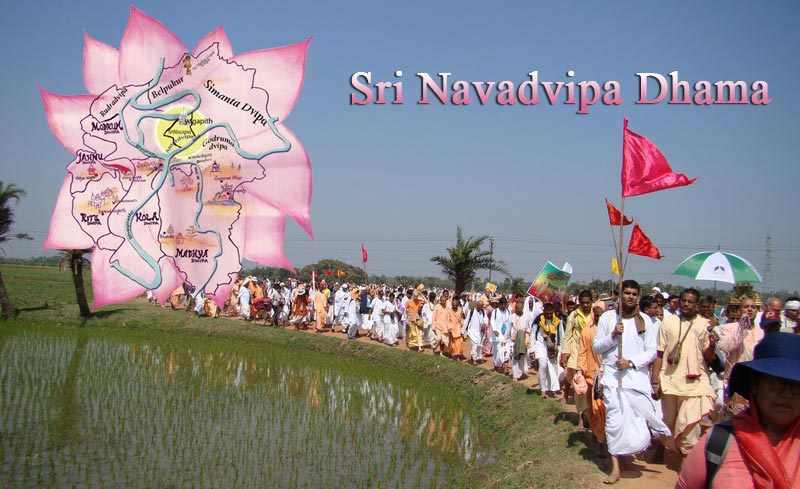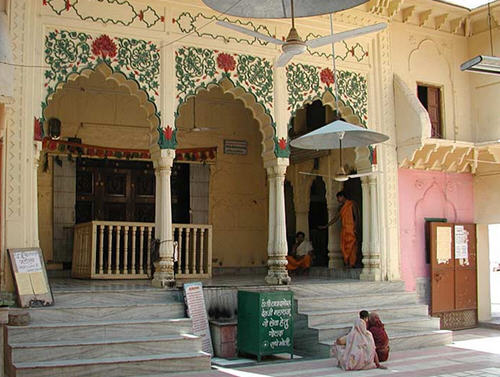
Sri Sri Radha Damodar Temple:
Established in 1542 by Jiva Goswami this temple is located at Seva Kunj. The founder acharya of International society for Krishna Consciousness, Srila Prabhupada, spent his time here meditating on his mission and doing bhajans before establishing the society.
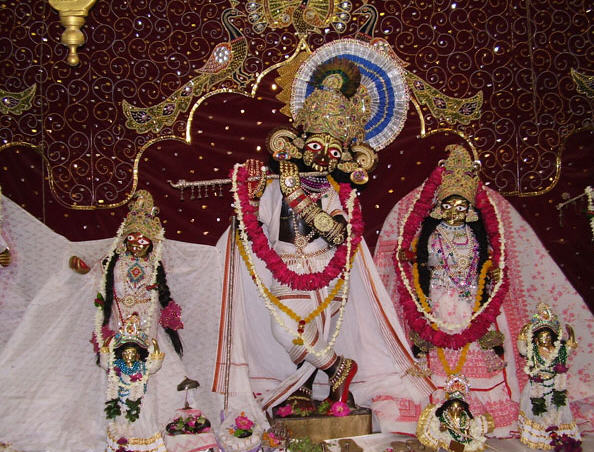
Sri Sri Radha Damodar:
Established by Srila Jiva Goswami in 1542 in the holy dham of Vrndavan, the Deities of Sri Sri Radha Damodar were given to Srila Jiva Goswami by his guru, Srila Rupa Goswami Prabhupada and have been worshiped here since then. The bhajan kutir and samadhi of Srila Rupa Goswami as well as the samadhis of Srila Jiva Goswami, Krsnadasa Kaviraja Goswami, Bhugarbha Goswami and the bhajan kutir of Srila A. C. Bhaktivedanta Swami Prabhupada are present here also on the temple premises. Presiding Deities are Sri Radha Damodar, worshipped by Srila Jiva Goswami, Sri Radha Vrndavan Chandra, worshiped by Srila Krishna Dasa Kaviraja Goswami, Sri Radha Madhava, worshipped by Srila Jayadeva Goswami, Sri Radha Chalacikan, worshipped by Srila Bhugarbha Goswami, and Govardhan Sila, worshipped by Srila Sanatana Goswami.
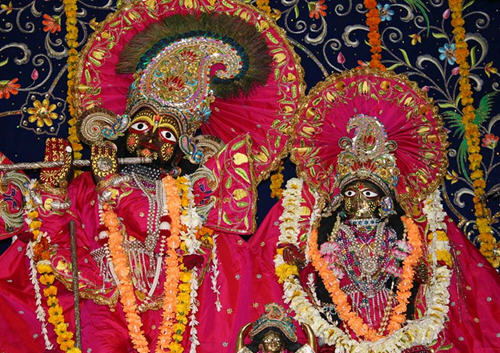
Sri Sri Radha Damodar:
In 1516, a year after Sri Caitanya Mahaprabhu visited Vrindavana-dhama, Srila Rupa Goswami and Srila Sanatana Goswami arrived there upon the order of the Lord to uncover the various lila-sthanas (pastime places) of Sri Krishna. They frequently traversed the entire land of Vraja and lived austerely, immersed in loving sentiments for the Divine Couple. During this time there was not a Temple in Vrindavana, only dense forests, so the Goswamis would live under the trees, under a thorn bush or in a vacant crocodile-hole. They remained for short periods to perform bhajana in Ter Kadamba, Varsana, Radha-kunda and the Radha Damodar temple area. Some years later, they were joined by their young nephew Sri Jiva, who took diksa from Srila Rupa Goswami and performed service at his lotus feet. According to Sri Radha-Krsna Goswami’s Sadhana-dipika, Sri Rupa was expert in drawing and preparing Deities. So it was that in 1542 he obtained a piece of black marble from the Vindya Mountains and in the sacred month of Damodar (Karttika), he personally carved, installed and offered a Deity of Lord Damodar to his intimate disciple Srila Jiva Goswami. Srila Jiva Goswami officially purchased land at Seva-kunja for thirty rupees in order to worship his beloved Lord. After the disappearance of Rupa and Sanatana, Jiva Goswami became the head of the Gaudiya sampradaya and the Radha Damodar Temple became famous as a seat of learning due to its vast library of rare books and manuscripts of the Goswamis. Some devotees are under the impression that the Deities of Radhadamodar in the Radhadamodar Temple in Vrndavan are not the original Deities of Srila Jiva Goswami. Some think that the original Deities now reside in Jaipur. However, this is not a fact. In 1670, when the Muslim fanatic Aurangazeb invaded Sri Vrndavana, he planned to destroy many temples and deface the Deities there. For this reason the principle Deities of Vraja were moved to the safe confines of the city of Jaipur in Rajasthan under the auspices of the Rajput kings. Most of the Deities remained there, such as Govindadeva, Gopinatha and Madana-mohana. The Radhadamodar Deities however returned to Vrndavana and have been worshiped there ever since. The Deities that replaced the originals in the temples of Govinda, Gopinatha and Madana-mohana are known as pratibhu-murtis which were installed and worshipped as substitute Deities by the Goswamis of those temples. All pratibhu-murtis are smaller in size than the original Deities installed by the acaryas, but it is worth noting that the Deity of Damodarji in Jaipur is smaller than the Deity in Vrndavana, thus further confirming that the original Deity of Sri Damodarji is in Vrndavana, whereas the pratibhu-murti is being worshipped in Jaipur today.

Sri Sri Radha Damodar Temple:
Before Sri Jiva’s disappearance in 1596, he left his Deities and library in the care of his successor Sri Krishna Dasa, the head pujari. The present sevaites are directly coming in line from his descendants.

…Other Deities worshiped here are the Radha Vrindavan-candra Deities worshipped by Krisnadas Kaviraj Goswami, the Radha-Madhava Deities of Jayadev Goswami, and the Radha-Chalacikana Deities of Bhugarbha Goswami. The original Deities were all moved to Jaipur… Original Radha Damodar Deities made by Rupa Goswami for Jiva (Jaipur)
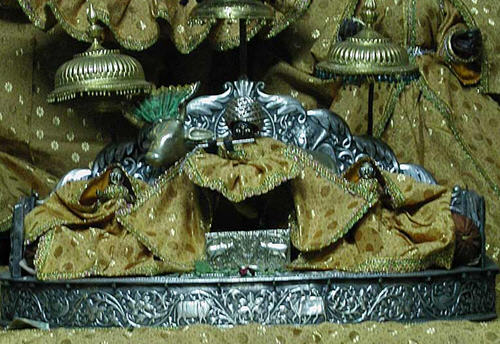
Original Radha Damodar Deities made by Rupa Goswami for Jiva (Jaipur)
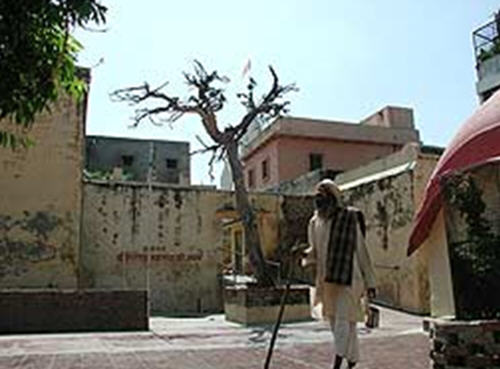
There is a Govardhan-sila in this temple that was worshiped by Sanatana Goswami. It has Lord Krisna’s footprint on it, and it was given to Sanatana Goswami by Krisna Himself. Sanatan was getting old and couldn’t circumambulate whole Govardhan any more (21 km)…
…Lord Krisna gave him this sila and told him that circumambulating this sila is as good as circumambulating the whole Govardhan Hill. For a small donation the pujari will show you this sila. You can see the imprints of Krisna’s footprint, walking stick, flute, and the hoof-print of a calf imbedded in the sila.
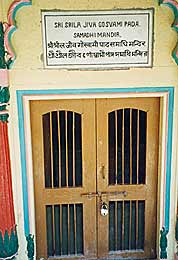
Samadhi of Jiva Goswami. Turning to the left entrance from the temple room, one goes into another courtyard. There one can find samadhi of Srila Jiva Goswami. In Gaura-gandodesa-dipika it is stated that he was actually Vilas Manjari. He was very found of Srimad-Bhagavatam even from his childhood and went to Navadvip to study Sanskrit. Nityananda Prabhu was his guide during Navadvip-parikram. After further studies in Benares he went to Vrindavan to help Rupa and Sanatan…
 ..
..
.After their departure he was adviser and acarya of all devotees. Jiva Goswami consolidated the works of his uncles Rupa and Sanatana Goswamis and compiled twenty five books of over 400 000 verses. Srila Prabhupada writes: “To understand Lord Caitanya, one has to follow the direst descendants of Lord Caitanya – the Six Goswamis – and especially the path chalked out by Srila Jiva Goswami.” Later he sent the next generation of Vaisnavas (Srinivas, Narottam and Syamanada) to preach to Bengal with a cart full of books written by Goswamis.

Jiva Goswami consolidated the works of his uncles Rupa and Sanatana Goswamis and compiled twenty five books of over 400 000 verses. Srila Prabhupada writes: “To understand Lord Caitanya, one has to follow the direst descendants of Lord Caitanya – the Six Goswamis – and especially the path chalked out by Srila Jiva Goswami.”
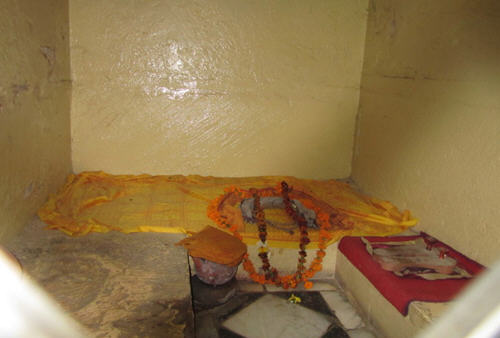
Samadhi of Jiva Goswami (left) and Krisnadas Kaviraj Goswami (right). Samadhi of Krisnadas Kaviraj Goswami Krisnadas Kaviraj Goswami is the author of celebrated classic Sri Caitanya-caritamrita. Once, Sri Nityananda appeared to him in a dream and told him to go to Vrindavan. He became disciple of Raghunath das Goswami and lived near his spiritual master at Radha-kund. In 1581 he completed Caitanya-caritamrita and one year later he entered samadhi. Krisnadas Kaviraj Goswami is and incarnation of Kasturi Manjari, Radharani’s maidservant.
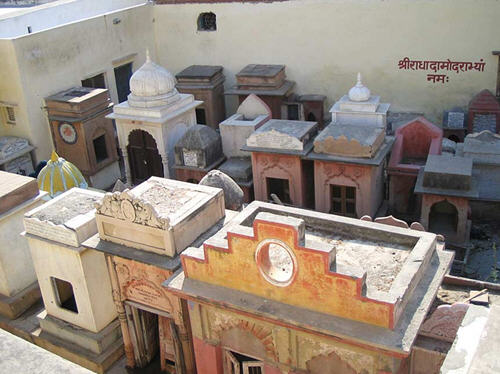
There are whole roads of different shrines and samadhis…
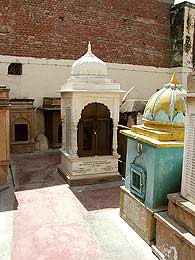
Puspa-samadhi of Bhaktisiddhanta Sarasvati..
.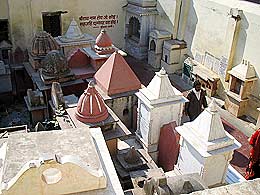 ..
..
.and puspa-samadhi of the king Birhambir who became Srinivasa’s disciple and transformed his kingdom into Vaisnava state and other vaisnava saints.
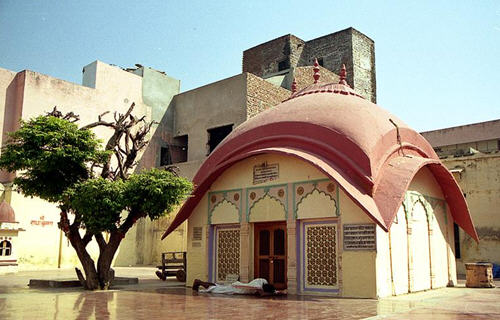
Samadhi of Srila Rupa Goswami is on another courtyard right to the altar.
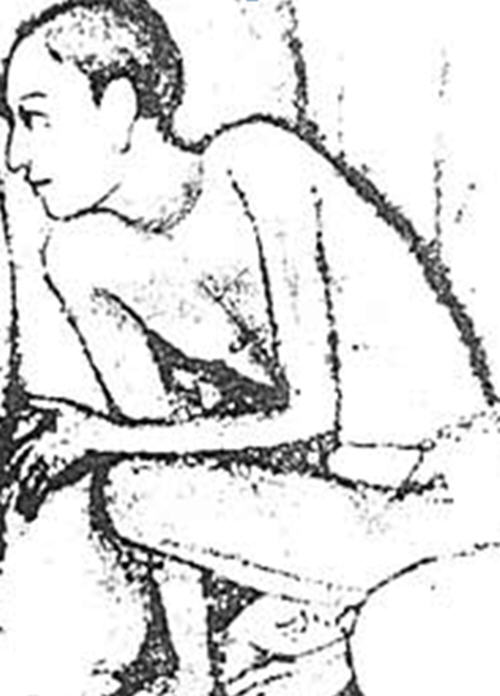
In Gaura-gandodesa-dipika Sri Rupa Goswami is described as gopi named Rupa-manjari – young personal maidservant of Srimati Radharani. On the order of Sri Caitanya Mahaprabhu Rupa Goswami wrote many books about the Vaisnava philosophy. Possibly the most famous of them is Bhakti-rasamrita-sindhu, translated into English as “Nectar of Devotion”. Rupa Goswami is protector and leader of devotees and his followers call themselves “rupanugas”. We can pray at his samadhi for his mercy so that at least little bit of transcendental glory of Vrindavan will be revealed to us.

This is his Samadhi
.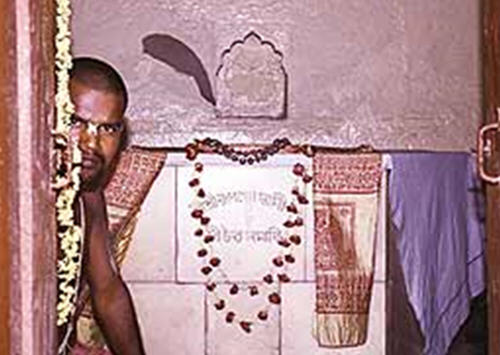
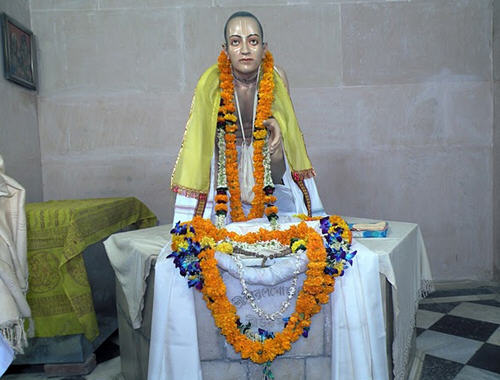
Inside the samadhi
.
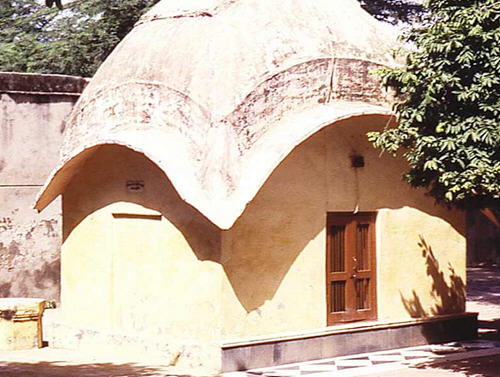
Bhajan-kutir of Srila Rupa Goswami is just next to his samadhi
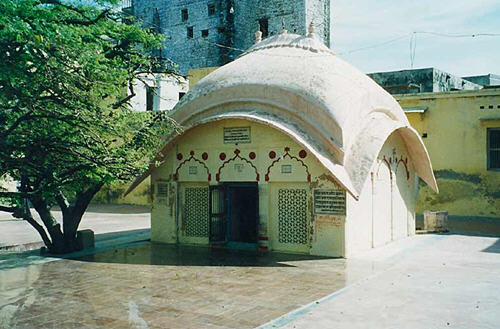
Between them there is sacred tamal tree. Tamal trees are very rare, hardly growing anywhere expect Vrindavan area. Their blackish bark resembles dark complexion of Lord Krisna. Gopis in time of intense fear or separation from their Lord began to embrace Tamal trees to get feeling of safety and His closeness
.
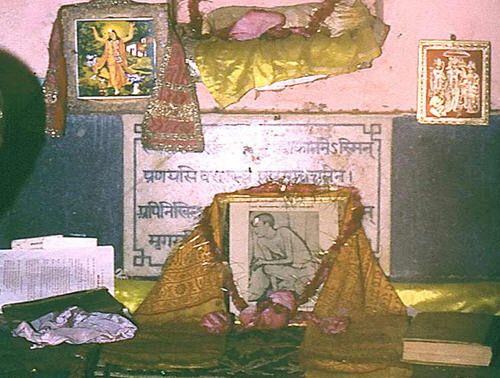
Inside bhajan-kutir is small humble altar. In his last days Rupa Goswami gave all the manuscripts to Jiva Goswami, requesting him to write the commentaries. In 1564, on Sravan-dvadasi-pavitra, Sri Rupa Goswami entered samadhi. Jiva Goswami placed his transcendental body to his samadhi mandir, where it stands now
.
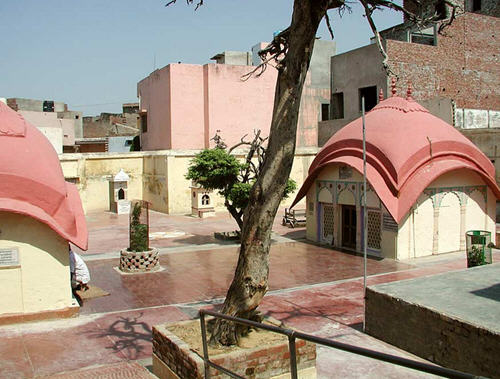
In his last days Rupa Goswami gave all the manuscripts to Jiva Goswami, requesting him to write the commentaries. In 1564, on Sravan-dvadasi-pavitra, Sri Rupa Goswami entered samadhi. Jiva Goswami placed his transcendental body to his samadhi mandir, where it stands now…
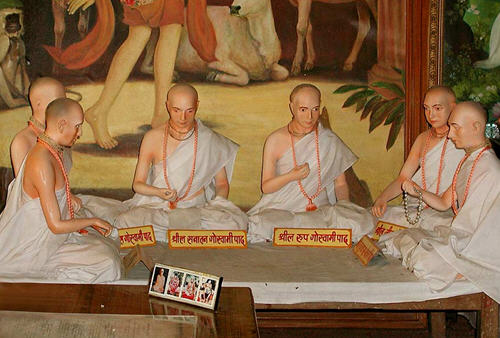
..On that most holy day, the Goswamis, Raghunath Bhatta, Gopal Bhatta, Raghunath das and all the Vaisnavas in attendance proclaimed to Jiva Goswami: “From this day on, you are our master, and our leader.”
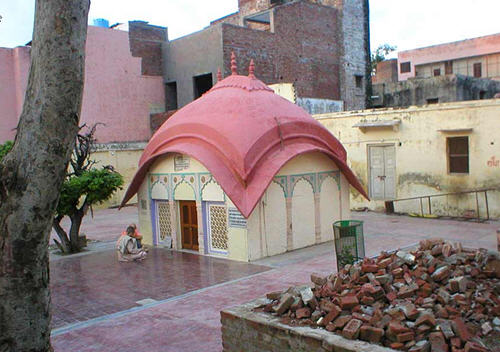
Shortly after Rupa’s disappearance, Jiva Goswami established a “Visva Vaisnava Raja Sabha”, a type of school or formal assembly to tech Sanskrit based on his own Hari-nama Vyakarana and the bhakti granthas of the Goswamis Bhakti-rasamrita-sindhu (Rupa Goswami), Brihad-bhagavatamrita (Sanatan Goswami) ad Ujjvala-nilamani. Jiva Goswami was the most systematic preacher, and was soon acclaimed as the greatest philosopher in all of India.
Although Radha-Damodar temple was not large and ornate, it was once famous for its vast library, where Jiva Goswami neatly stored all the original manuscripts of the Goswamis.
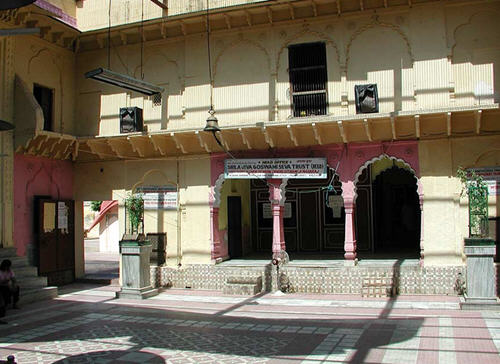
Although Radha-Damodar temple was not large and ornate, it was once famous for its vast library, where Jiva Goswami neatly stored all the original manuscripts of the Goswamis.
.
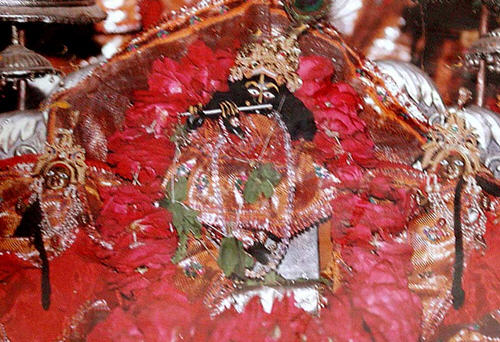
In 1670 demoniac Moghul Emperor Aurangzeb ruthlessly attacked Vrindavan Temples. Raiders, mistaking it for the private residence, didn’t defile the simple designed Radha-Damodar temple. But the Deities were moved to Jaipur before that. The temple priests implored the Jaipur king to return Deity and after a sixty-nine years in Jaipur, Radha-Damodar came home to Vrindavan. The Lord did not stay long, however, because a determined Maharaja Jai Singh prevailed upon Damodar’s priests to allow the Deity to move back to Jaipur, where He remains today
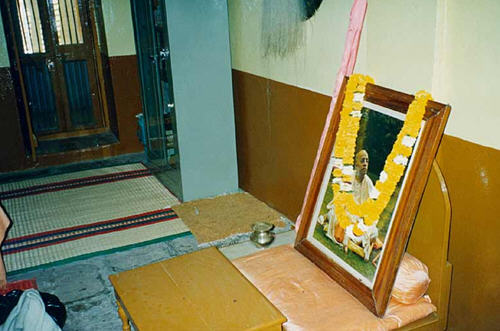
Prabhupada’s rooms
On the right side of the temple courtyard there are two rooms where Srila Prabhupada lived before his departure to America.
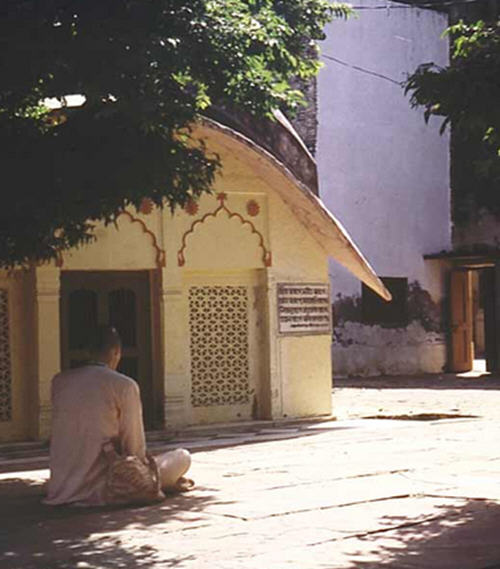
His small kitchen has a window (on the white wall behind) overlooking the samadhi of Srila Rupa Goswam
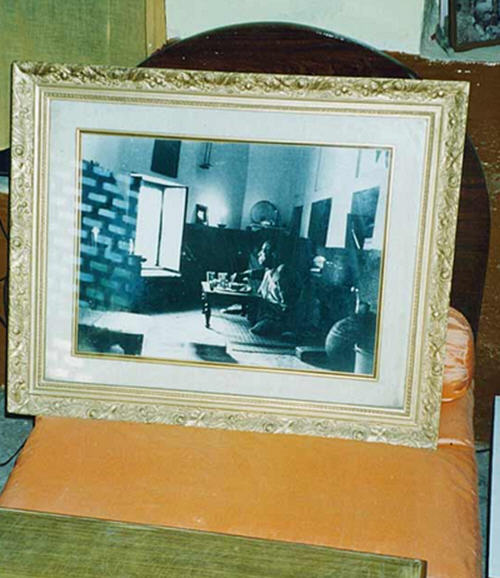
Srila Prabhupada often said he received great inspiration from Rupa Goswami

Simple living place of “Swami who is always writing”, how local people started to call him.
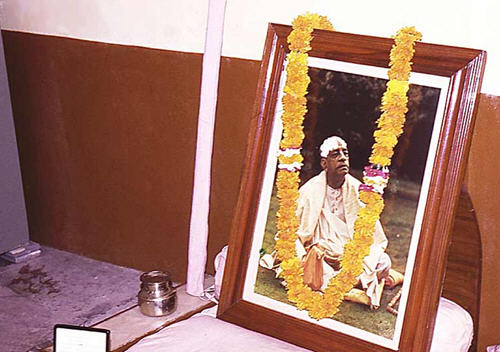
The worship in those rooms is carried out by Prabhupada’s disciples.
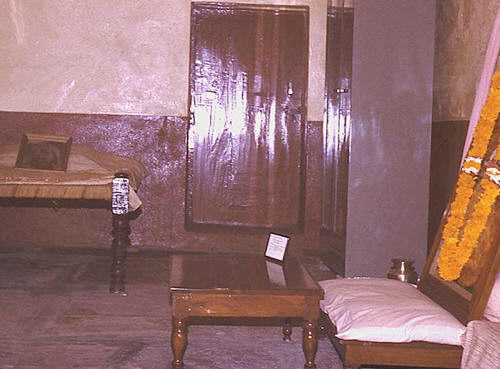
Srila Prabhupada lived here for nearly 6 years. He wrote and traveled to Delhi to publisher.
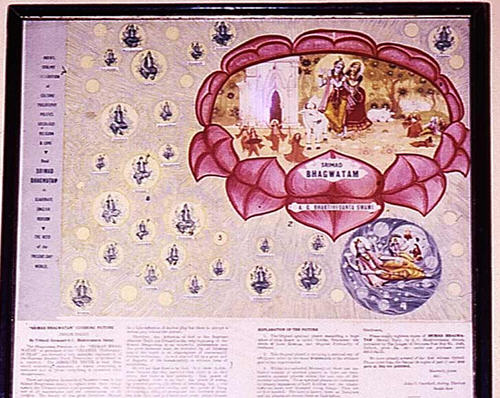
He was finishing the commentary to the first canto of Srimad-Bhagavatam. This part was published in India before his departure.
.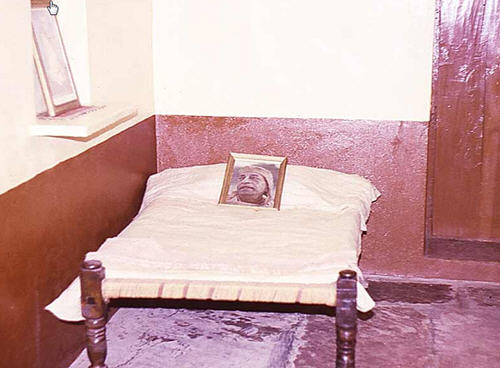
“I eternally reside in my rooms at the Radha-Damodar Temple,” said Srila Prabhupad many times

“When Krisna descended on the earth, He appeared in Vrindavan. Although I am presently living in America, my residence is in Vrindavan, because I am always thinking of Krisna. Although I may be in a New York apartment, my consciousness is there, and this is as good as living there.” Path of perfection, p.128
